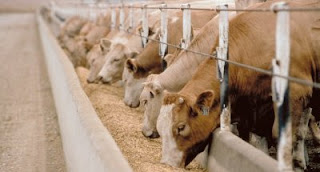The Federal Governments focus on the farming industry has
grown poultry produce by 50% in 2017. Analysts estimate the country would
achieve 85% sustainability by 2020. Making
poultry farmers the primary market for feed makers.
The cost of an animal feed plant depends on many factors.
They include size of the plant, type of equipment, staff, location and plant
capacity. You can start an animal feed plant with USD $19 million or USD
$50,000. It could be established in a massive warehouse or simple barn.
Feed
Types
Most livestock require some sort of feed. Common feed
type are poultry feed, dog food and sheep feed. Others are equine nutrition,
cattle feed, cat food, bird food and household pets. Catfish feed is also gaining
popularity in many parts of Nigeria.
- poultry feed
- dog food
- sheep feed
- equine nutrition
- cattle feed
- cat food
- bird food
- household pets
- catfish feed
Why
Start a Feed Mill Business
The local feed industry is grown at an impressive rate.
Local manufacturers have a steady source of raw materials and government
incentives.
Labor costs are also lower than advanced countries. And the
major challenges are utility, equipment and quality of the produce. Local
manufacturers are able to charge low prices than their foreign counterparts.
- steady supply of raw materials
- government incentives
- low labor costs
- charge low prices
- huge market base
How
to Establish a Feed Mill
Write
a Feed Mill Business Plan
Write a feed mill business plan before establishing the
business. Find a good location, purchase branded or fabricated machinery and
hire qualified staff. You need a good marketing strategy, business registration
and transportation.
Location
You can operate from a small shed or large warehouse. The
location should be accessible to heavy duty trucks and have good storage
facility. The location could be in an industrial or commercial area.
Licensing
You need an operational license to manufacture animal
feed. The feed should conform to NAFDAC quality control and ingredients.
You would need a NAFDAC number and Tax identification
number TIN. It is important you get insurance cover for the business.
Marketing
and Distribution
Feed Mill is an essential commodity for livestock farmers.
Without sustenance the animals would not grow or produce.
To market your feed you need to network with feed retail
outlets. Offer your produce at fair prices and give discounts.
The quality of your feed is very important to the
success. Farmers instinctively now the best feed through observation and growth
rate of their stock.
If your product is high quality they will buy
irrespective of the price. However keeping the price competitive is very
important.
Another way to sell your produce is via direct contact
with farmers. A big farm is capable of buying several tons of feed monthly.
Offer to transport the feed to the farm free of charge.
Other marketing strategy is to use electronic and print
media. Advertise on television and radio. Use flyers, posters, banners and
billboards.
Build
a Website
You can reach more people by building a website. Make
sure the site is easy to navigate and add you product image, sizes and
description. You are at liberty to add prices, customer service hot line and
contact form. Your website should target your demography and customer base.
Join
a Social Site.
Use social media to reach potential clients. You can
create a Facebook page and post regularly. The post should target your
demography, add images of your product, location and price.
Equipment
The type of equipment would produce either high grade or
low grade feed. Common equipment to consider is pelletizer, weight balance,
vertical mixer and hammer mill. Others are extrude, bulk storage system, conditioners,
coolers and dryers. More are crumblers.
- Pelletizer
- weight balance
- vertical mixer
- hammer mill
- extrude
- bulk storage system
- conditioners
- coolers
- dryers
- crumbler
Quality
Control
Quality control measures are important to achieve
uniformity. You need good looking product to compete with other brands.
Pay attention to the appearance and quality of the
extruded feed pellets. Things that affect quality are production process, type
of extruder and uniformity control. The grinding and particle size reduction
should be uniform.
Bagging
and Labeling
Feed are generally packaged in water tight bags. To differentiate
your product, brand the bag with your feed name and logo. On the label you need
to add product description, size and type of animal.
Labor
You need experienced staff to run the mill. Hire machine
operators, casuals, drivers, secretary and manager. You need an accountant, stock
manager and quality control managers.
Other staffs are marketers, casual labor and cleaners. A
small operation can survive with very few workers. However they may have to
perform dual roles and jobs.
Feed
Manufacturing
The process of making animal food from agricultural
products is feed manufacturing. The food is produced to accommodate specific
nutritional requirement of the animal.
The manufacturers also include whole grain and
concentrate into the mix. And the production is generally governed by state or
federal laws guiding the production.
Basic ingredients include roughage, cereal grains, grass
and concentrates. The formulation process differs from one animal to the next.
Different formulas are attributed to swine, fish, poultry or livestock.
Common
Ingredient in Animal Feed
Common ingredients in animal feed are cassava and bran.
Others include soy meal, rice bran and corn. The protein content is properly
regulated including energy and moisture.
Feed
Formulation Process
The process starts with the raw materials then quality
inspection. The batch is weighed before proceeding to the grinding station.
The next process is the mixing, pelleting and cooling
before the crumbing. The final product undergoes quality inspection, weighing
and packaging. Not all the products are sold straight from the shelf most are
sent to storage.










0 comments:
Post a Comment